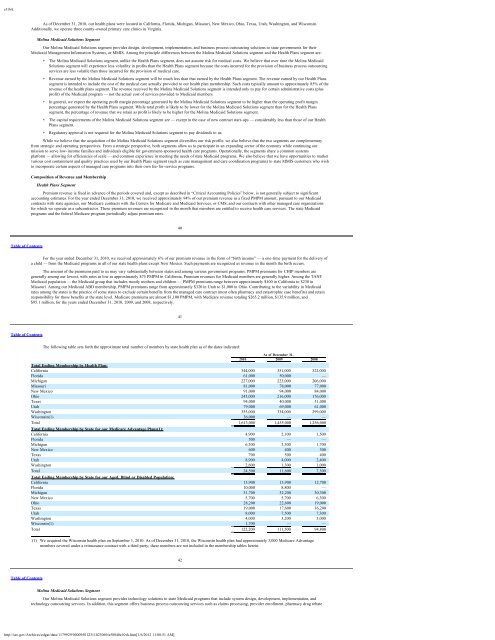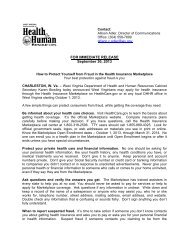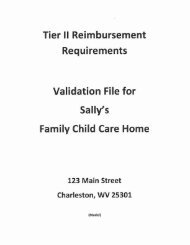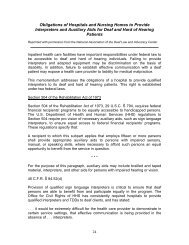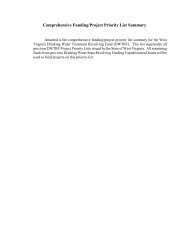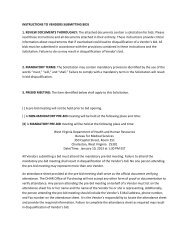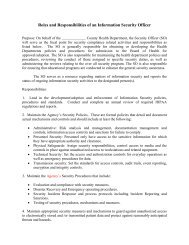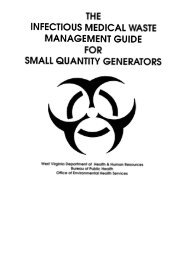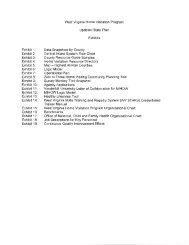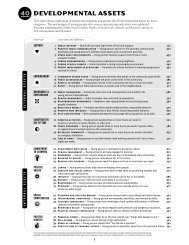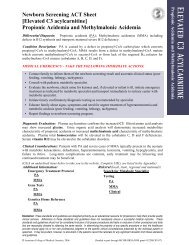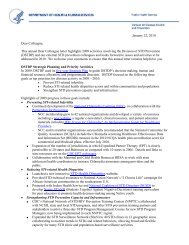e10vkAs of December 31, 2010, our health plans were located in California, Florida, Michigan, Missouri, New Mexico, Ohio, Texas, Utah, Washington, and Wisconsin.Additionally, we operate three county-owned primary care clinics in Virginia.<strong>Molina</strong> <strong>Medicaid</strong> <strong>Solutions</strong> SegmentOur <strong>Molina</strong> <strong>Medicaid</strong> <strong>Solutions</strong> segment provides design, development, implementation, and business process outsourcing solutions to state governments for their<strong>Medicaid</strong> Management Information Systems, or MMIS. Among the principle differences between the <strong>Molina</strong> <strong>Medicaid</strong> <strong>Solutions</strong> segment and the Health Plans segment are:• The <strong>Molina</strong> <strong>Medicaid</strong> <strong>Solutions</strong> segment, unlike the Health Plans segment, does not assume risk for medical costs. We believe that over time the <strong>Molina</strong> <strong>Medicaid</strong><strong>Solutions</strong> segment will experience less volatility in profits than the Health Plans segment because the costs incurred for the provision of business process outsourcingservices are less volatile than those incurred for the provision of medical care.• Revenue earned by the <strong>Molina</strong> <strong>Medicaid</strong> <strong>Solutions</strong> segment will be much less than that earned by the Health Plans segment. The revenue earned by our Health Planssegment is intended to include the cost of the medical care actually provided to our health plan membership. Such costs typically amount to approximately 85% of therevenue of the health plans segment. The revenue received by the <strong>Molina</strong> <strong>Medicaid</strong> <strong>Solutions</strong> segment is intended only to pay for certain administrative costs (plusprofit) of the <strong>Medicaid</strong> program — not the actual cost of services provided to <strong>Medicaid</strong> members.• In general, we expect the operating profit margin percentage generated by the <strong>Molina</strong> <strong>Medicaid</strong> <strong>Solutions</strong> segment to be higher than the operating profit marginpercentage generated by the Health Plans segment. While total profit is likely to be lower for the <strong>Molina</strong> <strong>Medicaid</strong> <strong>Solutions</strong> segment than for the Health Planssegment, the percentage of revenue that we retain as profit is likely to be higher for the <strong>Molina</strong> <strong>Medicaid</strong> <strong>Solutions</strong> segment.• The capital requirements of the <strong>Molina</strong> <strong>Medicaid</strong> <strong>Solutions</strong> segment are — except in the case of new contract start-ups — considerably less than those of our HealthPlans segment.• Regulatory approval is not required for the <strong>Molina</strong> <strong>Medicaid</strong> <strong>Solutions</strong> segment to pay dividends to us.While we believe that the acquisition of the <strong>Molina</strong> <strong>Medicaid</strong> <strong>Solutions</strong> segment diversifies our risk profile, we also believe that the two segments are complementaryfrom strategic and operating perspectives. From a strategic perspective, both segments allow us to participate in an expanding sector of the economy while continuing ourmission to serve low-income families and individuals eligible for government-sponsored health care programs. Operationally, the segments share a common systemsplatform — allowing for efficiencies of scale — and common experience in meeting the needs of state <strong>Medicaid</strong> programs. We also believe that we have opportunities to marketvarious cost containment and quality practices used by our Health Plans segment (such as care management and care coordination programs) to state MMIS customers who wishto incorporate certain aspects of managed care programs into their own fee-for-service programs.Composition of Revenue and MembershipHealth Plans SegmentPremium revenue is fixed in advance of the periods covered and, except as described in “Critical Accounting Policies” below, is not generally subject to significantaccounting estimates. For the year ended December 31, 2010, we received approximately 94% of our premium revenue as a fixed PMPM amount, pursuant to our <strong>Medicaid</strong>contracts with state agencies, our Medicare contracts with the Centers for Medicare and <strong>Medicaid</strong> Services, or CMS, and our contracts with other managed care organizationsfor which we operate as a subcontractor. These premium revenues are recognized in the month that members are entitled to receive health care services. The state <strong>Medicaid</strong>programs and the federal Medicare program periodically adjust premium rates.40Table of ContentsFor the year ended December 31, 2010, we received approximately 6% of our premium revenue in the form of “birth income” — a one-time payment for the delivery ofa child — from the <strong>Medicaid</strong> programs in all of our state health plans except New Mexico. Such payments are recognized as revenue in the month the birth occurs.The amount of the premiums paid to us may vary substantially between states and among various government programs. PMPM premiums for CHIP members aregenerally among our lowest, with rates as low as approximately $75 PMPM in California. Premium revenues for <strong>Medicaid</strong> members are generally higher. Among the TANF<strong>Medicaid</strong> population — the <strong>Medicaid</strong> group that includes mostly mothers and children — PMPM premiums range between approximately $100 in California to $230 inMissouri. Among our <strong>Medicaid</strong> ABD membership, PMPM premiums range from approximately $320 in Utah to $1,000 in Ohio. Contributing to the variability in <strong>Medicaid</strong>rates among the states is the practice of some states to exclude certain benefits from the managed care contract (most often pharmacy and catastrophic case benefits) and retainresponsibility for those benefits at the state level. Medicare premiums are almost $1,100 PMPM, with Medicare revenue totaling $265.2 million, $135.9 million, and$95.1 million, for the years ended December 31, 2010, 2009, and 2008, respectively.41Table of ContentsThe following table sets forth the approximate total number of members by state health plan as of the dates indicated:As of December 31,2010 2009 2008Total Ending Membership by Health Plan:California 344,000 351,000 322,000Florida 61,000 50,000 —Michigan 227,000 223,000 206,000Missouri 81,000 78,000 77,000New Mexico 91,000 94,000 84,000Ohio 245,000 216,000 176,000Texas 94,000 40,000 31,000Utah 79,000 69,000 61,000Washington 355,000 334,000 299,000Wisconsin(1) 36,000 — —Total 1,613,000 1,455,000 1,256,000Total Ending Membership by State for our Medicare Advantage Plans(1):California 4,900 2,100 1,500Florida 500 — —Michigan 6,300 3,300 1,700New Mexico 600 400 300Texas 700 500 400Utah 8,900 4,000 2,400Washington 2,600 1,300 1,000Total 24,500 11,600 7,300Total Ending Membership by State for our Aged, Blind or Disabled Population:California 13,900 13,900 12,700Florida 10,000 8,800 —Michigan 31,700 32,200 30,300New Mexico 5,700 5,700 6,300Ohio 28,200 22,600 19,000Texas 19,000 17,600 16,200Utah 8,000 7,500 7,300Washington 4,000 3,200 3,000Wisconsin(1) 1,700 — —Total 122,200 111,500 94,800(1) We acquired the Wisconsin health plan on September 1, 2010. As of December 31, 2010, the Wisconsin health plan had approximately 3,000 Medicare Advantagemembers covered under a reinsurance contract with a third party; these members are not included in the membership tables herein.42Table of Contents<strong>Molina</strong> <strong>Medicaid</strong> <strong>Solutions</strong> SegmentOur <strong>Molina</strong> <strong>Medicaid</strong> <strong>Solutions</strong> segment provides technology solutions to state <strong>Medicaid</strong> programs that include system design, development, implementation, andtechnology outsourcing services. In addition, this segment offers business process outsourcing services such as claims processing, provider enrollment, pharmacy drug rebatehttp://sec.gov/Archives/edgar/data/1179929/000095012311023069/a58840e10vk.htm[1/6/2012 11:08:51 AM]
e10vkservices, recipient eligibility management, and pre-authorization services to state <strong>Medicaid</strong> agencies.<strong>Molina</strong> <strong>Medicaid</strong> <strong>Solutions</strong> has contracts with five states to design, develop, implement, maintain, and operate <strong>Medicaid</strong> Management Information Systems (MMIS).These contracts extend over a number of years, and cover the life of the MMIS from inception through at least the first five years of its operation. The contracts are subject toextension by the exercise of an option, and also by renewal of the base contract. The contracts have a life cycle beginning with the design, development, and implementation ofthe MMIS and continuing through the operation of the system. Payment during the design, development, and implementation phase of the contract, or the DDI phase, isgenerally based upon the attainment of specific milestones in systems development as agreed upon ahead of time by the parties. Payment during the operations phase typicallytakes the form of either a flat monthly fee or payment for specific measures of capacity or activity, such as the number of claims processed, or the number of <strong>Medicaid</strong>beneficiaries served by the MMIS. Contracts may also call for the adjustment of amounts paid if certain activity measures exceed or fall below certain thresholds. In somecircumstances, revenue recognition may be delayed for long periods while we await formal customer acceptance of our products and/or services. In those circumstances,recognition of a portion of our costs may also be deferred.Under our contracts in Louisiana, New Jersey, and West Virginia, we provide primarily business process outsourcing and technology outsourcing services, because thedevelopment of the MMIS solution has been completed. Under these contracts, we recognize outsourcing service revenue on a straight-line basis over the remaining term of thecontract. In Maine, we completed the DDI phase of our contract effective September 1, 2010. In Idaho, we expect to complete the DDI phase of our contract during 2011. Webegan revenue and cost recognition for our Maine contract in September 2010, and expect to begin revenue and cost recognition for our Idaho contract in 2011.Additionally, <strong>Molina</strong> <strong>Medicaid</strong> <strong>Solutions</strong> provides pharmacy rebate administration services under a contract with the state of Florida.Composition of ExpensesHealth Plans SegmentOperating expenses for the Health Plans segment include expenses related to the provision of medical care services, G&A expenses, and premium tax expenses. Ourresults of operations are impacted by our ability to effectively manage expenses related to medical care services and to accurately estimate medical costs incurred. Expensesrelated to medical care services are captured in the following four categories:• Fee-for-service — Physician providers paid on a fee-for-service basis are paid according to a fee schedule set by the state or by our contracts with the providers. Wepay hospitals on a fee-for-service basis in a variety of ways, including by per diem amounts, by diagnostic-related groups, or DRGs, as a percentage of billed charges,and by case rates. We also pay a small portion of hospitals on a capitated basis. We also have stop-loss agreements with the hospitals with which we contract; undercertain circumstances, we pay escalated charges in connection with these stop-loss agreements. Under all fee-for-service arrangements, we retain the financialresponsibility for medical care provided. Expenses related to fee-for-service contracts are recorded in the period in which the related services are dispensed. The costsof drugs administered in a physician or hospital setting that are not billed through our pharmacy benefit managers are included in fee-for-service costs.• Capitation — Many of our primary care physicians and a small portion of our specialists and hospitals are paid on a capitated basis. Under capitation contracts, wetypically pay a fixed PMPM payment to the provider without regard to the frequency, extent, or nature of the medical services actually furnished. Under capitatedcontracts, we remain liable for the provision of certain health care services. Certain of our capitated contracts also contain incentive programs based on servicedelivery, quality of care, utilization management,43Table of Contentsand other criteria. Capitation payments are fixed in advance of the periods covered and are not subject to significant accounting estimates. These payments areexpensed in the period the providers are obligated to provide services. The financial risk for pharmacy services for a small portion of our membership is delegated tocapitated providers.• Pharmacy — Pharmacy costs include all drug, injectibles, and immunization costs paid through our pharmacy benefit managers. As noted above, drugs andinjectibles not paid through our pharmacy benefit manager are included in fee-for-service costs, except in those limited instances where we capitate drug andinjectible costs.• Other — Other medical care costs include medically related administrative costs, certain provider incentive costs, reinsurance costs, and other health care expense.Medically related administrative costs include, for example, expenses relating to health education, quality assurance, case management, disease management, 24-houron-call nurses, and a portion of our information technology costs. Salary and benefit costs are a substantial portion of these expenses. For the years endedDecember 31, 2010, 2009 and 2008, medically related administrative costs were approximately $85.5 million, $74.6 million and $75.9 million, respectively.Our medical care costs include amounts that have been paid by us through the reporting date as well as estimated liabilities for medical care costs incurred but not paidby us as of the reporting date. See “Critical Accounting Policies” below for a comprehensive discussion of how we estimate such liabilities.<strong>Molina</strong> <strong>Medicaid</strong> <strong>Solutions</strong> SegmentCost of service revenue consists primarily of the costs incurred to provide business process outsourcing and technology outsourcing services under our contracts inLouisiana, Maine, New Jersey, West Virginia and Florida, as well as certain selling, general and administrative expenses. Additionally, certain indirect costs incurred under ourcontracts in Maine (prior to exiting the DDI phase of that contract in September, 2010) and Idaho are also expensed to cost of services.In some circumstances we may defer recognition of incremental direct costs (such as direct labor, hardware, and software) associated with a contract if revenuerecognition is also deferred. Such deferred contract costs are amortized on a straight-line basis over the remaining original contract term, consistent with the revenue recognitionperiod. We began to recognize deferred costs for our Maine contract in September 2010, at the same time we began to recognize revenue associated with that contract. InIdaho, we expect to begin recognition of deferred contact costs during 2011, in a manner consistent with our anticipated recognition of revenue.Results of OperationsYear Ended December 31, 2010 Compared with the Year Ended December 31, 2009Health Plans SegmentPremium RevenuePremium revenue grew 9.0% in the year ended December 31, 2010, compared with the year ended December 31, 2009, due to a membership increase of 10.9%. On aPMPM basis, however, consolidated premium revenue decreased 2.1% because of declines in premium rates. The decrease in PMPM revenue was due to the transfer of thepharmacy benefit to the state fee-for-service programs in Ohio (effective February 1, 2010) and Missouri (effective October 1, 2009). Exclusive of the transfer of the pharmacybenefit in Ohio and Missouri, <strong>Medicaid</strong> premium revenue PMPM increased approximately 1.5% over the year ended December 31, 2009. Medicare enrollment exceeded24,000 members at December 31, 2010, and Medicare premium revenue was $265.2 million for the year ended December 31, 2010, compared with $135.9 million for the yearended December 31, 2009.44Table of ContentsMedical Care CostsThe following table provides the details of consolidated medical care costs for the periods indicated (dollars in thousands except PMPM amounts):Year Ended December 31,2010 2009% of % ofAmount PMPM Total Amount PMPM TotalFee-for-service $ 2,360,858 $ 128.73 70.0% $ 2,077,489 $ 126.14 65.4%Capitation 555,487 30.29 16.5 558,538 33.91 17.6Pharmacy 325,935 17.77 9.7 414,785 25.18 13.1Other 128,577 7.01 3.8 125,424 7.62 3.9Total $ 3,370,857 $ 183.80 100.0% $ 3,176,236 $ 192.85 100.0%The medical care ratio decreased to 84.5% for the year ended December 31, 2010, compared with 86.8% for the year ended December 31, 2009.The medical care ratio of the California health plan decreased to 83.5% for the year ended December 31, 2010, compared with 92.2% for the year ended December 31,2009, primarily due to lower inpatient facility fee-for-service costs resulting from provider network restructuring and improved medical management.The medical care ratio of the Florida health plan increased to 95.4% for the year ended December 31, 2010, from 93.8% for the year ended December 31, 2009,primarily due to higher capitation costs and higher fee-for-service costs in the outpatient and physician categories.The medical care ratio of the Michigan health plan increased to 83.7% for the year ended December 31, 2010, from 81.5% for the year ended December 31, 2009,primarily due to higher inpatient facility fee-for-service costs.The medical care ratio of the New Mexico health plan decreased to 80.6% for the year ended December 31, 2010, from 85.7% for the year ended December 31, 2009,primarily due to reduced fee-for-service costs which more than offset decreased premium revenue PMPM.The medical care ratio of the Ohio health plan decreased to 79.1% for the year ended December 31, 2010, from 86.1% for the year ended December 31, 2009, primarilydue to an increase in <strong>Medicaid</strong> premium PMPM of approximately 6% effective January 1, 2010 (exclusive of the reduction related to pharmacy benefits), partially offset byhttp://sec.gov/Archives/edgar/data/1179929/000095012311023069/a58840e10vk.htm[1/6/2012 11:08:51 AM]
- Page 1:
Molina Medicaid SolutionsResponse t
- Page 7 and 8:
Bridging the Rivers ofChange Togeth
- Page 9 and 10:
Bridging the Rivers ofChange Togeth
- Page 11 and 12:
Bridging the Rivers ofChange Togeth
- Page 13 and 14:
Bridging the Rivers ofChange Togeth
- Page 15 and 16:
Bridging the Rivers ofChange Togeth
- Page 17 and 18:
Bridging the Rivers ofChange Togeth
- Page 19 and 20:
Bridging the Rivers ofChange Togeth
- Page 21 and 22:
Bridging the Rivers ofChange Togeth
- Page 23 and 24:
Bridging the Rivers ofChange Togeth
- Page 25 and 26:
Bridging the Rivers ofChange Togeth
- Page 27 and 28:
Bridging the Rivers ofChange Togeth
- Page 29 and 30:
Bridging the Rivers ofChange Togeth
- Page 31 and 32:
Bridging the Rivers ofChange Togeth
- Page 33 and 34:
Bridging the Rivers ofChange Togeth
- Page 35 and 36:
Bridging the Rivers ofChange Togeth
- Page 37 and 38:
Bridging the Rivers ofChange Togeth
- Page 39 and 40:
Bridging the Rivers ofChange Togeth
- Page 41 and 42:
Bridging the Rivers ofChange Togeth
- Page 43 and 44:
Bridging the Rivers ofChange Togeth
- Page 45 and 46:
Bridging the Rivers ofChange Togeth
- Page 47 and 48:
Bridging the Rivers ofChange Togeth
- Page 49 and 50:
Bridging the Rivers ofChange Togeth
- Page 51 and 52:
Bridging the Rivers ofChange Togeth
- Page 53 and 54:
Bridging the Rivers ofChange Togeth
- Page 55 and 56:
Bridging the Rivers ofChange Togeth
- Page 57 and 58:
Bridging the Rivers ofChange Togeth
- Page 59 and 60:
Bridging the Rivers ofChange Togeth
- Page 61 and 62:
Bridging the Rivers ofChange Togeth
- Page 63 and 64:
Bridging the Rivers ofChange Togeth
- Page 65 and 66:
Bridging the Rivers ofChange Togeth
- Page 67 and 68:
Bridging the Rivers ofChange Togeth
- Page 69 and 70:
Bridging the Rivers ofChange Togeth
- Page 71 and 72:
Bridging the Rivers ofChange Togeth
- Page 73 and 74:
Bridging the Rivers ofChange Togeth
- Page 75 and 76:
Bridging the Rivers ofChange Togeth
- Page 77 and 78:
Bridging the Rivers ofChange Togeth
- Page 79 and 80:
Bridging the Rivers ofChange Togeth
- Page 81 and 82:
Bridging the Rivers ofChange Togeth
- Page 83 and 84:
Bridging the Rivers ofChange Togeth
- Page 85 and 86:
Bridging the Rivers ofChange Togeth
- Page 87 and 88:
Bridging the Rivers ofChange Togeth
- Page 89 and 90:
Bridging the Rivers ofChange Togeth
- Page 91 and 92:
Bridging the Rivers ofChange Togeth
- Page 93 and 94:
Bridging the Rivers ofChange Togeth
- Page 95 and 96:
Bridging the Rivers ofChange Togeth
- Page 97 and 98:
Bridging the Rivers ofChange Togeth
- Page 99 and 100:
Bridging the Rivers ofChange Togeth
- Page 101 and 102:
Bridging the Rivers ofChange Togeth
- Page 103 and 104:
Bridging the Rivers ofChange Togeth
- Page 105 and 106:
Bridging the Rivers ofChange Togeth
- Page 107 and 108:
Bridging the Rivers ofChange Togeth
- Page 109 and 110:
Bridging the Rivers ofChange Togeth
- Page 111 and 112:
Bridging the Rivers ofChange Togeth
- Page 113 and 114:
Bridging the Rivers ofChange Togeth
- Page 115 and 116:
Bridging the Rivers ofChange Togeth
- Page 117 and 118:
Bridging the Rivers ofChange Togeth
- Page 119 and 120:
Bridging the Rivers ofChange Togeth
- Page 121 and 122:
Bridging the Rivers ofChange Togeth
- Page 123 and 124:
Bridging the Rivers ofChange Togeth
- Page 125 and 126:
Bridging the Rivers ofChange Togeth
- Page 127 and 128:
Bridging the Rivers ofChange Togeth
- Page 129 and 130:
Bridging the Rivers ofChange Togeth
- Page 131 and 132:
Bridging the Rivers ofChange Togeth
- Page 133 and 134:
Bridging the Rivers ofChange Togeth
- Page 135 and 136:
Bridging the Rivers ofChange Togeth
- Page 137 and 138:
Bridging the Rivers ofChange Togeth
- Page 139 and 140:
Bridging the Rivers ofChange Togeth
- Page 141 and 142:
Bridging the Rivers ofChange Togeth
- Page 143 and 144:
Bridging the Rivers ofChange Togeth
- Page 145 and 146:
Bridging the Rivers ofChange Togeth
- Page 147 and 148:
Bridging the Rivers ofChange Togeth
- Page 149 and 150:
Bridging the Rivers ofChange Togeth
- Page 151 and 152:
Bridging the Rivers ofChange Togeth
- Page 153 and 154:
Bridging the Rivers ofChange Togeth
- Page 155 and 156:
Bridging the Rivers ofChange Togeth
- Page 157 and 158:
Bridging the Rivers ofChange Togeth
- Page 159 and 160:
Bridging the Rivers ofChange Togeth
- Page 161 and 162:
Bridging the Rivers ofChange Togeth
- Page 163 and 164:
Bridging the Rivers ofChange Togeth
- Page 165 and 166:
Bridging the Rivers ofChange Togeth
- Page 167 and 168:
Bridging the Rivers ofChange Togeth
- Page 169 and 170:
Bridging the Rivers ofChange Togeth
- Page 171 and 172:
Bridging the Rivers ofChange Togeth
- Page 173 and 174:
Bridging the Rivers ofChange Togeth
- Page 175 and 176:
Bridging the Rivers ofChange Togeth
- Page 177 and 178:
Bridging the Rivers ofChange Togeth
- Page 179 and 180:
Bridging the Rivers ofChange Togeth
- Page 181 and 182:
Bridging the Rivers ofChange Togeth
- Page 183 and 184:
Bridging the Rivers ofChange Togeth
- Page 185 and 186:
Bridging the Rivers ofChange Togeth
- Page 187 and 188:
Bridging the Rivers ofChange Togeth
- Page 189 and 190:
Bridging the Rivers ofChange Togeth
- Page 191 and 192:
Bridging the Rivers ofChange Togeth
- Page 193 and 194:
Bridging the Rivers ofChange Togeth
- Page 195 and 196:
Bridging the Rivers ofChange Togeth
- Page 197 and 198:
Bridging the Rivers ofChange Togeth
- Page 199 and 200:
Bridging the Rivers ofChange Togeth
- Page 201 and 202:
Bridging the Rivers ofChange Togeth
- Page 203 and 204:
Bridging the Rivers ofChange Togeth
- Page 205 and 206:
Bridging the Rivers ofChange Togeth
- Page 207 and 208:
Bridging the Rivers ofChange Togeth
- Page 209 and 210:
Bridging the Rivers ofChange Togeth
- Page 211 and 212:
Bridging the Rivers ofChange Togeth
- Page 213 and 214:
Bridging the Rivers ofChange Togeth
- Page 215 and 216:
Bridging the Rivers ofChange Togeth
- Page 217 and 218:
Bridging the Rivers ofChange Togeth
- Page 219 and 220:
Bridging the Rivers ofChange Togeth
- Page 221 and 222:
Bridging the Rivers ofChange Togeth
- Page 223 and 224:
Bridging the Rivers ofChange Togeth
- Page 225 and 226:
Bridging the Rivers ofChange Togeth
- Page 227 and 228:
Bridging the Rivers ofChange Togeth
- Page 229 and 230:
Bridging the Rivers ofChange Togeth
- Page 231 and 232:
Bridging the Rivers ofChange Togeth
- Page 233 and 234:
Bridging the Rivers ofChange Togeth
- Page 235 and 236:
Bridging the Rivers ofChange Togeth
- Page 237 and 238:
Bridging the Rivers ofChange Togeth
- Page 239 and 240:
Bridging the Rivers ofChange Togeth
- Page 241 and 242:
Bridging the Rivers ofChange Togeth
- Page 243 and 244:
Bridging the Rivers ofChange Togeth
- Page 245 and 246:
Bridging the Rivers ofChange Togeth
- Page 247 and 248:
Bridging the Rivers ofChange Togeth
- Page 249 and 250:
Bridging the Rivers ofChange Togeth
- Page 265:
Bridging the Rivers ofChange Togeth
- Page 272 and 273:
Bridging the Rivers ofChange Togeth
- Page 274 and 275:
Bridging the Rivers ofChange Togeth
- Page 276 and 277:
Bridging the Rivers ofChange Togeth
- Page 278 and 279:
Bridging the Rivers ofChange Togeth
- Page 280 and 281:
Bridging the Rivers ofChange Togeth
- Page 282 and 283:
Bridging the Rivers ofChange Togeth
- Page 284 and 285:
Bridging the Rivers ofChange Togeth
- Page 286 and 287:
Bridging the Rivers ofChange Togeth
- Page 288 and 289:
Bridging the Rivers ofChange Togeth
- Page 290 and 291:
Bridging the Rivers ofChange Togeth
- Page 292 and 293:
Bridging the Rivers ofChange Togeth
- Page 294 and 295:
Bridging the Rivers ofChange Togeth
- Page 296 and 297:
Bridging the Rivers ofChange Togeth
- Page 298 and 299:
Bridging the Rivers ofChange Togeth
- Page 300 and 301:
Bridging the Rivers ofChange Togeth
- Page 302 and 303:
Bridging the Rivers ofChange Togeth
- Page 304 and 305:
Bridging the Rivers ofChange Togeth
- Page 306 and 307:
Bridging the Rivers ofChange Togeth
- Page 308 and 309:
Bridging the Rivers ofChange Togeth
- Page 310 and 311:
Bridging the Rivers ofChange Togeth
- Page 312 and 313:
Bridging the Rivers ofChange Togeth
- Page 314 and 315:
Bridging the Rivers ofChange Togeth
- Page 316 and 317:
Bridging the Rivers ofChange Togeth
- Page 318 and 319:
Bridging the Rivers ofChange Togeth
- Page 320 and 321:
Bridging the Rivers ofChange Togeth
- Page 322 and 323:
Bridging the Rivers ofChange Togeth
- Page 324 and 325:
Bridging the Rivers ofChange Togeth
- Page 326 and 327:
Bridging the Rivers ofChange Togeth
- Page 328 and 329:
Bridging the Rivers ofChange Togeth
- Page 330 and 331:
Bridging the Rivers ofChange Togeth
- Page 332 and 333:
Bridging the Rivers ofChange Togeth
- Page 334 and 335:
Bridging the Rivers ofChange Togeth
- Page 336 and 337:
e10vkTable of ContentsItem 1:Overvi
- Page 338 and 339:
e10vkDepartment of Health Services
- Page 340 and 341:
e10vkservices, and reputation or na
- Page 342 and 343:
e10vkIf our government contracts ar
- Page 344 and 345:
e10vkIf our cost increases resultin
- Page 346 and 347:
e10vkour board of directors. Becaus
- Page 348 and 349:
e10vkFirst Quarter $ 44.94 $ 23.46S
- Page 350 and 351:
e10vkTable of ContentsCertain compo
- Page 352 and 353:
e10vkNevada 8,037 1,106.45 9,099 1,
- Page 354 and 355:
e10vkInvestment IncomeInvestment in
- Page 356 and 357:
e10vkand 2007, respectively. EBITDA
- Page 358 and 359:
e10vk$2.8 million, or $0.10 per dil
- Page 360 and 361:
e10vkREPORT OF INDEPENDENT REGISTER
- Page 362 and 363:
e10vk65Table of ContentsMOLINA HEAL
- Page 364 and 365:
e10vkDelegated Provider InsolvencyC
- Page 366 and 367:
e10vk2007 (see Note 11, “Long-Ter
- Page 368 and 369:
e10vk$ 252,380 $ 248,039Gross reali
- Page 370 and 371:
e10vkTable of ContentsMOLINA HEALTH
- Page 372 and 373:
e10vk$10.9 million, and $7.9 millio
- Page 374 and 375:
e10vkIn July 2008, our board of dir
- Page 376 and 377:
e10vkThe Registrant has an equity i
- Page 378 and 379:
e10vkSIGNATURESPursuant to the requ
- Page 380 and 381:
exv12w1EX-12.1 2 a51362exv12w1.htm
- Page 382 and 383:
exv23w1EX-23.1 4 a51362exv23w1.htm
- Page 384 and 385:
exv31w2EX-31.2 6 a51362exv31w2.htm
- Page 386 and 387:
exv32w2EX-32.2 8 a51362exv32w2.htm
- Page 388 and 389:
e10vkEX-31.1EX-31.2EX-32.1EX-32.2Ta
- Page 390 and 391:
e10vkLeverage operational efficienc
- Page 392 and 393:
e10vkhealth plans. Among such facto
- Page 394 and 395:
e10vkMissouri and Ohio health plans
- Page 396 and 397:
e10vkWe are subject to various rout
- Page 398 and 399:
e10vkIt may be difficult for a thir
- Page 400 and 401:
e10vkItem 5:PART IIMarket for Regis
- Page 402 and 403:
e10vkstates to exclude certain bene
- Page 404 and 405:
e10vkMedical care ratio 86.8% 84.8%
- Page 406 and 407:
e10vkTable of ContentsMedical care
- Page 408 and 409:
e10vkare required to pay a fee for
- Page 410 and 411:
e10vkknown. While we believe our cu
- Page 412 and 413:
e10vkTable of ContentsMOLINA HEALTH
- Page 414 and 415:
e10vkYear Ended December 31,2009 20
- Page 416 and 417:
e10vkCalifornia $ 481,717 $ 417,027
- Page 418 and 419:
e10vkMOLINA HEALTHCARE, INC.NOTES T
- Page 420 and 421:
e10vk2008, we had transitioned fewe
- Page 422 and 423:
e10vknot intend to sell, nor is it
- Page 424 and 425:
e10vk87Table of ContentsMOLINA HEAL
- Page 426 and 427:
e10vkDuring 2009, 2008, and 2007, t
- Page 428 and 429:
e10vk$29.17 - $30.05 9,350 5.9 $ 29
- Page 430 and 431:
e10vk(1) The Registrant’s condens
- Page 432 and 433:
e10vkChanges in Internal Controls:
- Page 434 and 435:
e10vkSignature Title Date/s/ Joseph
- Page 436 and 437:
exv10w22Commitments exceed the sum
- Page 438 and 439:
exv10w22Loan Document. The amendmen
- Page 440 and 441:
exv10w22Name:Title:Fifth Amendment
- Page 442 and 443:
exv10w22Fifth Amendment to Credit A
- Page 444 and 445:
exv10w24EX-10.24 3 a55407exv10w24.h
- Page 446 and 447:
exv10w24Molina ECMS ref# 729 Provid
- Page 448 and 449:
exv10w24Molina ECMS ref# 729 Provid
- Page 450 and 451:
exv10w24HSA — Hospital Services A
- Page 452 and 453:
exv10w243.2 Member Eligibility Dete
- Page 454 and 455:
exv10w245.6 Amendment. Health Plan
- Page 456 and 457:
exv10w24HSA — Hospital Services A
- Page 458 and 459:
exv10w24License No. StreetNPI (or U
- Page 460 and 461:
exv10w24Page 23 of 40ATTACHMENT CPr
- Page 462 and 463:
exv10w24• This reimbursement meth
- Page 464 and 465:
exv10w24Molina ECMS ref# 729 Provid
- Page 466 and 467: exv10w24(Rule 53250(e)(4))8. Provid
- Page 468 and 469: exv10w241. Right to Audit. Provider
- Page 470 and 471: exv10w24Treasurer G. William Hammer
- Page 472 and 473: exv10w25unless the situation is one
- Page 474 and 475: exv10w25Plan in identifying, proces
- Page 476 and 477: exv10w25Page 9that the offset and r
- Page 478 and 479: exv10w25under this Agreement.h. Hea
- Page 480 and 481: exv10w25Page 16Date 6/1/06ATTACHMEN
- Page 482 and 483: exv10w25that Provider is de-delegat
- Page 484 and 485: exv10w25the subscriber or Member by
- Page 486 and 487: exv10w25discretion, that Provider h
- Page 488 and 489: exv10w252.5 Annual Disclosure of Ca
- Page 490 and 491: exv10w25Initials of authorizedrepre
- Page 492 and 493: exv10w25the report is true and corr
- Page 494 and 495: exv21w1EX-21.1 6 a55407exv21w1.htm
- Page 496 and 497: exv31w1EX-31.1 8 a55407exv31w1.htm
- Page 498 and 499: exv32w1EX-32.1 10 a55407exv32w1.htm
- Page 500 and 501: e10vk10-K 1 a58840e10vk.htm FORM 10
- Page 502 and 503: e10vkOur StrengthsWe focus on servi
- Page 504 and 505: e10vkevent.CompetitionWe operate in
- Page 506 and 507: e10vkat the funding for these healt
- Page 508 and 509: e10vk18Table of ContentsAlso, many
- Page 510 and 511: e10vkTable of Contentsalleged non-c
- Page 512 and 513: e10vk(fair value of $20.4 million).
- Page 514 and 515: e10vkTable of ContentsSTOCK PERFORM
- Page 519 and 520: e10vkYear Ended December 31,2010 20
- Page 521 and 522: e10vkAcquisitionsWisconsin Health P
- Page 523 and 524: e10vkspecific performance measures
- Page 525 and 526: e10vkoverestimations were tied to o
- Page 527 and 528: e10vkIntangible assets, net 105,500
- Page 529 and 530: e10vkOur Health Plans segment compr
- Page 531 and 532: e10vkSituations may arise where the
- Page 533 and 534: e10vkinvestment fund. As of Decembe
- Page 535 and 536: e10vk87Table of ContentsMOLINA HEAL
- Page 537 and 538: e10vk7. ReceivablesHealth Plans seg
- Page 539 and 540: e10vkTable of ContentsMOLINA HEALTH
- Page 541 and 542: e10vkindebtedness under the Credit
- Page 543 and 544: e10vkstatutory capital and surplus
- Page 545 and 546: e10vkCash paid in business purchase
- Page 547 and 548: e10vkItem 12.Security Ownership of
- Page 549 and 550: exv10w27EX-10.27 2 a58840exv10w27.h
- Page 551 and 552: exv10w27(f) all transferable or ass
- Page 553 and 554: exv10w27and other charges have been
- Page 555 and 556: exv10w27under or affecting the Prop
- Page 557 and 558: exv10w27BY A GENERAL RELEASE, WHICH
- Page 559 and 560: exv10w27(f) Seller’s share of the
- Page 561 and 562: exv10w2710.6 Items Not to be Prorat
- Page 563 and 564: exv10w27- 21 -(i) Delinquency Repor
- Page 565 and 566: exv10w27executed, and delivered by
- Page 567 and 568:
exv10w27MATERIALS THAT PERTAIN TO T
- Page 569 and 570:
exv10w27Attn: General CounselTeleph
- Page 571 and 572:
exv10w2718.16 Authority. The indivi
- Page 573 and 574:
exv12w1EX-12.1 3 a58840exv12w1.htm
- Page 575 and 576:
exv23w1EX-23.1 5 a58840exv23w1.htm
- Page 577 and 578:
exv31w2EX-31.2 7 a58840exv31w2.htm
- Page 579:
exv32w2EX-32.2 9 a58840exv32w2.htm


